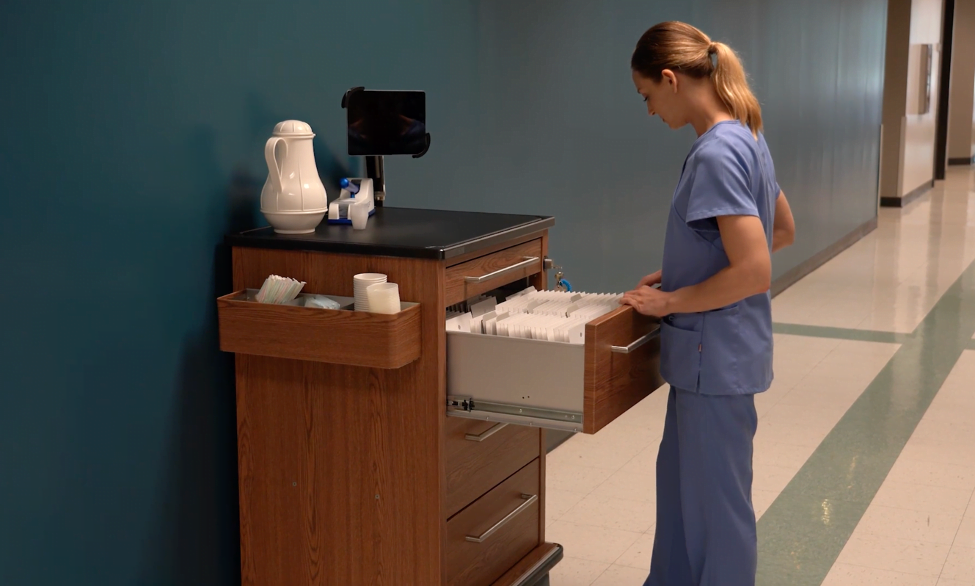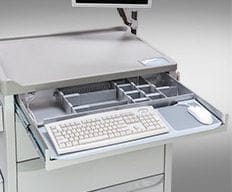
Medication is one of the cornerstones of treatment, and delivering the right medication to the right resident efficiently in extended-care facilities can be significantly enhanced when the pharmacy and nurses are using the right method. The time-honored saying, “The right tool for the job” applies perfectly to the med pass process in a senior care home. Consider these points when choosing the right medication cart for your facility, resident population, and nurses’ needs.
Medication carts are the proven method in a variety of post-acute healthcare settings, providing nurses with a mobile, well-equipped, and organized workstation that, when built correctly, can significantly improve nurse efficiency and comfort and ultimately free up time for the nurse to deliver excellent care to the facility’s residents. As with any workstation, choosing the best medication cart depends on several key considerations.
Medication carts bring efficiency, flexibility, and safety to the healthcare setting. With orderly medication access, healthcare providers can deliver better, safer patient care.
The right cart secures access to routine daily medications, Stat and emergency doses, and medical supplies. It functions seamlessly with your technology and blends into your facility space. However, a medication trolley or cart is only efficient if it’s durable, accessible, organized, and fits your needs.
Every setting and facility serves different types of patients with varying medication needs. For example, hospice and hospital patients have higher immediate medication needs than patients in long-term care facilities. Each facility may also have different procedures. The wrong features in a cart may create a clunky and frustrating dispensing process, leading to higher inefficiencies, possible errors, and operational costs.
The first step in choosing your cart is considering how and where you manage medication for your residents and within your facility. Examine dispensing patterns, high-traffic areas, a devoted “med room”, and assess the space and physical components your nursing staff navigates.
Your facility plays a vital role in determining the features you need on your cart. For example, tile, carpet, and elevators in high-traffic areas may be challenging to navigate, requiring heavy-duty casters. If you frequently move carts from one room to another, you will need quality casters and fasteners that will endure high usage, roll easily, and stay still when not in use.
Next, think about cart capacity and the resident population. Most studies of senior care conclude that residents take between 8 and 10 prescription medications daily for multiple chronic conditions. Long-term care facilities or nursing home med carts will likely need to store large amounts of medications. A rehabilitation center, on the other hand, may have a wider range of younger or middle-aged patients who are on fewer maintenance medications.
In cases with high-acuity patients, you’ll need a larger cart with a maximum storage capacity. Otherwise, medical staff will be back and forth to the med room or storage room, making the process longer.
Also, consider how your staff dispenses those medications. Maybe you deliver meds with water or juice or offer oral supplements to support nutritional needs during a med pass. In these cases, you’ll need equipment with additional storage, above-the-cart liquids management, or large drawers to double as medical supply holding zones.

Assess the role of technology during medication preparation and administration, for facilities that want nurses to have close access to electronic health records (EHR). Tech-ready carts with computer or tablet mounts and even an integrated keyboard tray or pull-out shelf are ideal for EHR updates during the med pass. A mounted computer – whether a laptop, tablet, or all-in-one medical-grade computer – may work best as it frees up the medication cart’s surface for use as a workspace.
Computer mounting also may include the ability to tilt and pivot for different nurses’ heights and preferences, and even allow the computer to be turned 90 degrees while the cart is being moved to avoid blocking the nurse’s sight line.
A related consideration for computing during the med pass is to determine if a locking mechanism is needed to prevent computers from falling. At the same time, the cart is in motion or theft. Cart manufacturers frequently provide several options, from essential to high-security computer mounting hardware.
Next, evaluate your facility for storage space. High-acuity patients mean you may need large carts, but these must also fit in available space. If you’re struggling to accommodate all your equipment or find your workstations are in the halls, consider carts with a slim profile and deep drawers to lessen the footprint.
Drawer accessibility is another important factor and helps avoid fatigue for the caregiver. Cart manufacturers may offer a variety of drawer handles, upgradeable drawer glides, and soft-close drawers for easy opening and closing.
Sanitation is an important consideration in post-acute settings. See if all outer surfaces are easily accessed for cleaning. Are there deep grooves or areas for liquids to pool, that will make cleaning difficult? Do the drawers offer seamless construction to prevent pooling? Can the carts be cleaned with available cleansers your facility already has? Does the cart provider offer accessories designed to store plenty of cleaning materials, hand sanitizer, wipes, etc.?
Some facilities store additional supplies on the floor in treatment carts, which can improve accessibility for medical staff. Many manufacturers make matching sets of medication and treatment carts and can help you gain this extra storage.
Finally, consider how your carts fit into the decor. For example, furniture-style carts may blend better into nursing homes or long-term care facilities that are less clinical and more home-inspired in design. This is especially important to consider if the home is about to undergo a remodel.
Medication packaging is another critical factor in choosing the right medication cart. Talk to your pharmacy provider about medication delivery and packaging, which will impact how you select and configure carts.
There are many types of medication delivery systems, but in North America for instance, trends follow three methods: Punch card (or bingo card); Unit dose (or strip packaging); and a method growing in popularity, Multi-dose (or large-format blister card, including branded examples like Dispill®, Jones Packaging® Tri-Fold, Pharmacy Automation Supplies Muti-Dose)
If the facility and providing pharmacy prefer other medication delivery systems (e.g., Spoolstor), many cart manufacturers have the ability to adapt drawer dividers, drawer depths, and locking systems.
Regardless of the medication system employed at the facility, the medication cart should be organized to efficiently handle each method. This would determine the cart’s drawer depths and widths, internal rails or organizing channels to hold doses, adjustable dividers, and labeling to organize meds by resident or room. Ideally, any cart, regardless of the medication delivery method, should offer lightweight drawers with flexible organization inside to support the nurses’ quick access for the right resident’s medications.
Mobile medication carts with integrated computing also function as mobile workstations, making the med pass more accessible to medical professionals. These carts are intelligent platforms that combine medication management with the technology you need to update electronic records and charts.
Rather than moving back and forth between patients and static workstations, medical staff can bring the computer to the patient and streamline the workflow at the point of care, improving care delivery. Mobile workstations provide ample med storage and include security and power systems onboard.

Other key features and accessories are essential components of your carts, including technology, locking systems, accessories, and structure. An ideal product has a lightweight but durable frame with various drawers and configurations that are easy to open. Most standard-line medication carts include these features.
Large carts may be essential, but staff also need to be able to move them around the floor. Look for carts with a handle and premium casters for easy maneuvering. Some medication carts are steel, but these should still be lightweight and easy to push.
Locking functions are vital to secure medication carts, especially for narcotics. The manual lock and key is often a standard feature, but keyless locks, auto relocking, and keycard entry are also available. The lock type may depend on your specific facility requirements, IT system, and need for narcotics control.
Manufacturers can add other technology to improve medication tracking, safety, and efficiency, such as barcode scanners, access control, user tracking, and cart fleet virtual management. However, if you decide on standard equipment, be sure it has the option to adopt or retrofit technology later as your systems evolve.
Finally, look for products with essential medical accessories such as sharps containers, waste bins, brakes, slide-out shelves, glove boxes, labels, and specialty narcotic drawers.
Your medication carts should have all the necessary features and accessories to promote safety and efficiency. Ultimately, choosing the best fit involves combined input from the institutional pharmacy that is providing the medications to the facility, the nursing staff that is using the carts daily, the facility administration that has ultimate oversight of resident care, and the medication cart manufacturer that can provide a variety of models, sizes, accessories, and organizational methods inside the carts.
Capsa Healthcare offers tailored medication cart solutions for any type of post-acute care facility. Contact us today to help you choose the right cart and features based on your resident population, medication distribution model and cycle length, and nurses’ workflow.